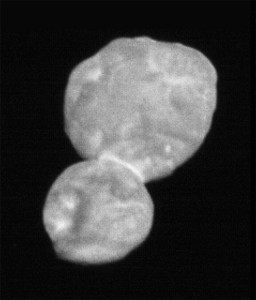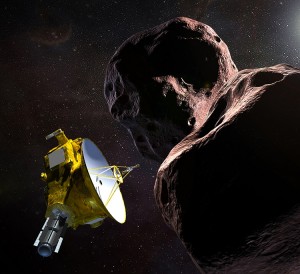Distant Ultima Thule
Wednesday, January 16th, 2019January 16, 2019
On January 1, the United States National Aeronautics and Space Administration (NASA) probe New Horizons flew by a 21-mile- (34-kilometer-) long rock at the outer reaches of our solar system. The probe took the rock’s first “close-up” photos, revealing details of the snowman-shaped space object, called 2014 MU69 or “Ultima Thule.” The term Thule was used by ancient European cartographers to describe the farthest northern lands of Earth. Ultima Thule (farthermost Thule) once described areas beyond the known world. Ultima Thule, then, is a fitting name for the distant object: it is 4 billion miles (6.5 billion kilometers) from Earth.

The New Horizons spacecraft took this photo of Ultima Thule on Jan. 1, 2019, from a distance of some 18,000 miles (28,000 kilometers). Credit: NASA/Johns Hopkins University Applied Physics Laboratory/Southwest Research Institute
New Horizons is the first spacecraft to study Pluto and the Kuiper belt, a band of icy bodies largely beyond the orbit of the planet Neptune. New Horizons flew past Pluto in July 2015, revealing a surprisingly varied and geologically active world. Despite its distance from the sun, Pluto has been molded and shaped by many of the same forces that created the eight planets of our solar system.
With the flyby of Ultima Thule, New Horizons became the first spacecraft to visit an object discovered after the spacecraft was launched. The craft blasted off from Cape Canaveral Air Force Station in Florida in 2006. Astronomers discovered Ultima Thule in 2014.

This NASA illustration shows New Horizons encountering 2014 MU69–“Ultima Thule.” Credit: NASA/JHUAPL/SwRI
What’s so special about Ultima Thule? It may look like just another space rock, but it is far different from the asteroids and comets found closer to the sun. The solar system’s planets and other inner objects have been transformed by the sun’s extreme heat, by catastrophic collisions, and by immense gravitational pressures. Ultima Thule and other Kuiper belt objects (KBO’s) are like frozen time capsules that show how things looked as the solar system was forming. The first grainy photographs of Ultima Thule show an object made up of two lobes that likely came together in a walking-speed “collision”—a rather serene birth in an otherwise violent universe.
New Horizons has completed its study of Ultima Thule, but NASA expects to learn more about the distant object over the next 20 months or so as information continues to trickle in. It takes a while for data to be transmitted across the immense distance to Earth. And this may not be the last distant flyby for New Horizons. NASA is searching for other space objects to visit before New Horizons runs out of power in the mid-2030’s.


